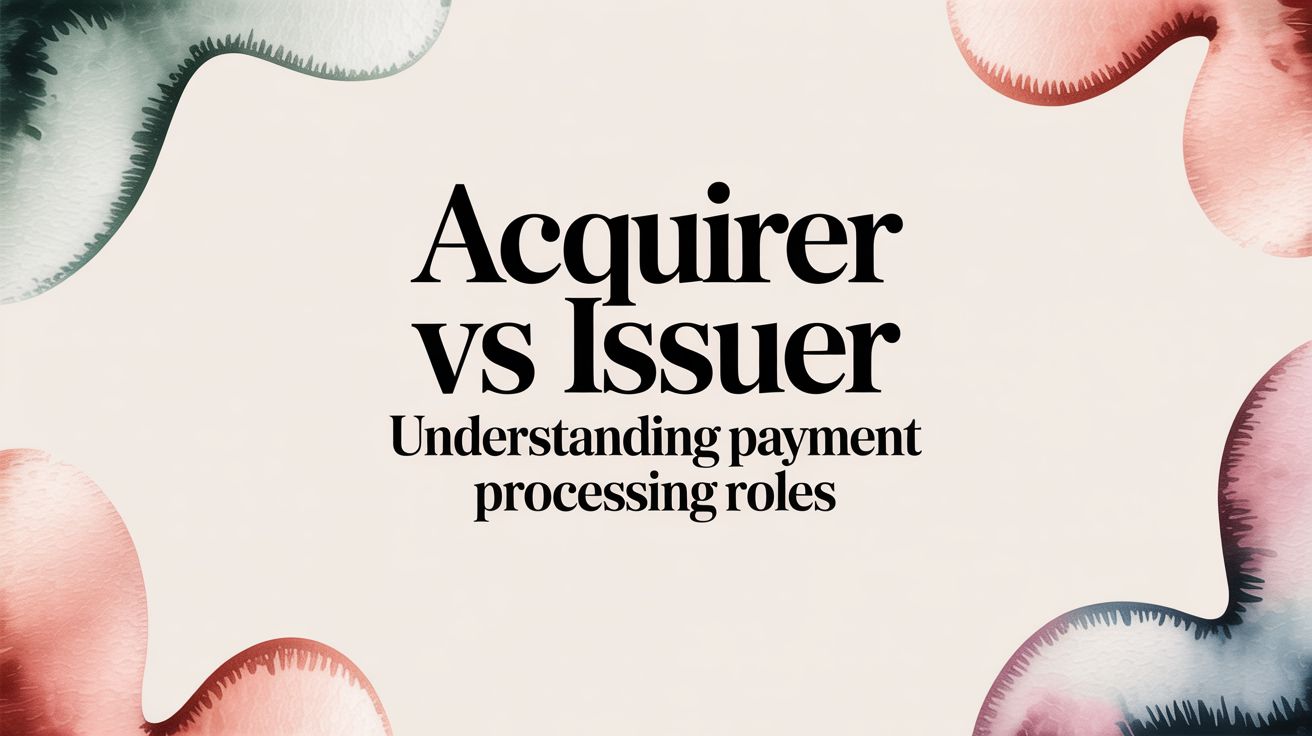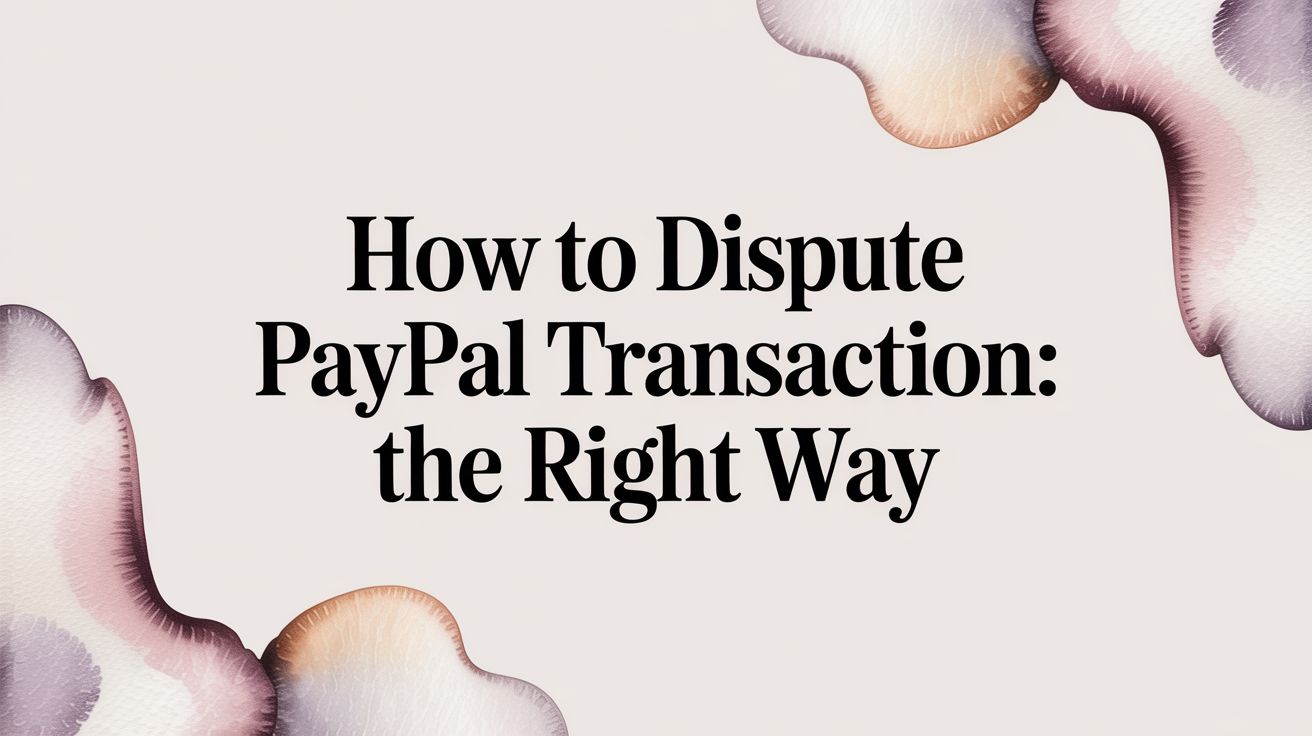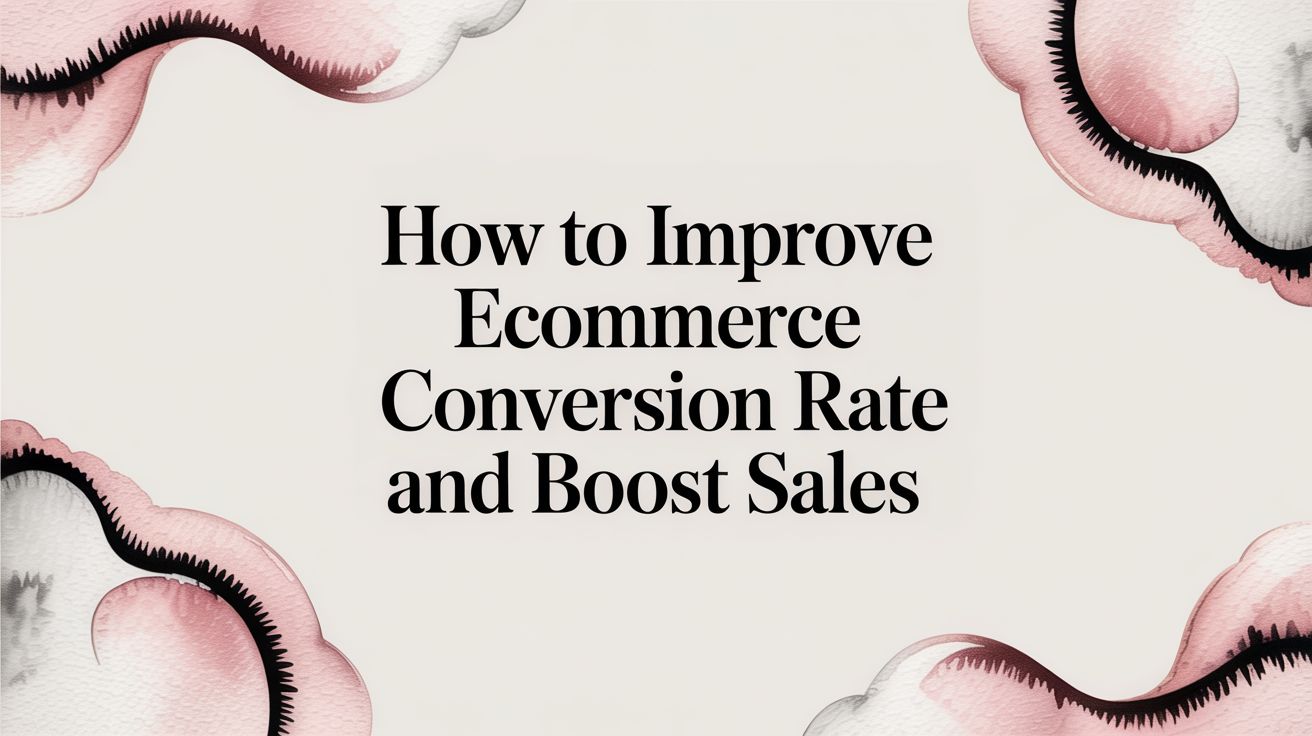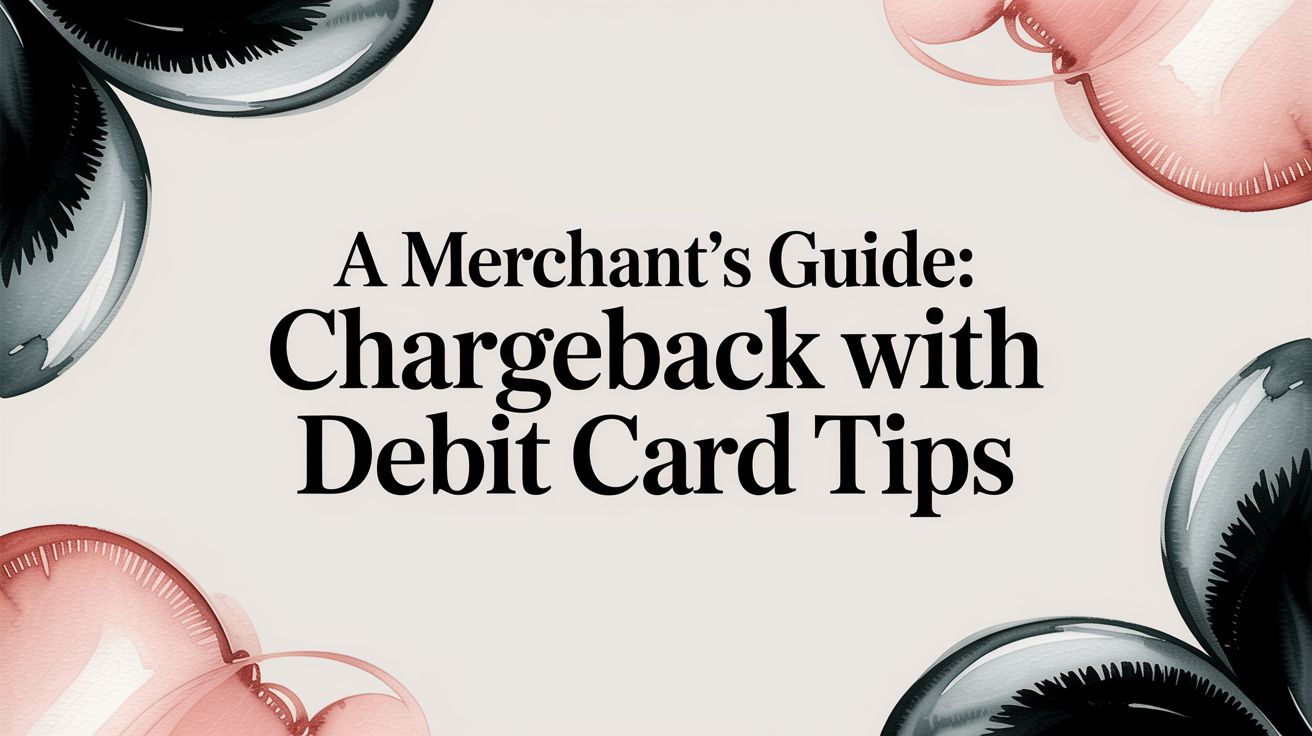
When a customer taps their card at checkout, the payment feels instant. But behind that simple action, two critical players are having a rapid-fire conversation: the acquirer and the issuer.
Getting this straight is fundamental: the issuer is the cardholder's bank, and the acquirer is the merchant's bank. As a business owner, knowing how each one operates is key to understanding where your money comes from and where it goes.
Understanding the Key Players in Every Transaction
Every single time a card is used, a complex dialogue kicks off between these two financial institutions. The issuer acts on behalf of your customer, while the acquirer is squarely in your corner.
Think of the issuer as the bank that put the card in your customer’s wallet—like Chase or Capital One. Their main job is to give a thumbs-up or thumbs-down on the transaction. They check if the customer has enough funds or available credit to cover the purchase.
On the other side of that coin is the acquirer. This is the financial institution that provides your business with a merchant account, which is what lets you accept card payments in the first place. Their role is to grab the transaction details from your payment terminal, send them through the card networks (like Visa or Mastercard), and once the issuer gives the green light, deposit the funds into your business account.
This whole back-and-forth is part of a massive global machine. Every year, an estimated 468 billion payment card transactions happen worldwide. Each one hinges on this clean division of labor between acquirers and issuers to go off without a hitch. You can find more incredible stats about the payment world over at Stripe.com.
Key Takeaway: The issuer works for the cardholder, managing their account and approving funds. The acquirer works for the merchant, processing the payment and settling the funds.
To really nail down the distinction, let's break down their core functions. While they have to work together, their responsibilities—and who they ultimately answer to—are worlds apart. For a deeper look into another crucial piece of this puzzle, check out our guide on what a payment processor is.
Quick Look: Acquirer vs. Issuer at a Glance
To make it even clearer, here’s a simple table that lays out the core differences. Think of this as your cheat sheet for telling these two essential players apart.
In short, while both are banks, they serve opposite ends of the transaction. The issuer focuses on the consumer, while the acquirer is dedicated to making sure you, the merchant, get paid.
How a Single Transaction Actually Works
So, what really happens from the moment a customer swipes, taps, or clicks to buy something from you? To the shopper, it feels instant. But behind the scenes, a high-speed conversation is kicking off between the acquirer and the issuer, with card networks like Visa and Mastercard acting as the messengers.
This whole dance breaks down into three main stages: authorization, clearing, and settlement. Getting a handle on this flow is crucial because it shows exactly how the acquirer and issuer work together to move money from your customer’s account into yours. Think of it this way: the acquirer makes the request on your behalf, while the issuer gives the final thumbs-up from the customer's side.
The Payment Journey from Start to Finish
It all begins with the authorization request. When a card is used, your payment terminal or online gateway zips the transaction details over to your acquiring bank. The acquirer then shoots this information through the correct card network straight to the customer's issuing bank.
The issuer gets the request and runs a quick but critical check. Is the card valid? Are there any red flags for fraud? Does the customer actually have enough funds or credit to cover the purchase? Within seconds, they fire back an approval or decline, which travels the same path back to your terminal, and voilà—the customer sees "Approved."
This infographic shows you the back-and-forth between everyone involved.

As you can see, the acquirer and issuer are the bookends of the transaction. The card networks are just the super-fast highway connecting them.
From Authorization to Settlement
Once the purchase is approved, the journey isn't quite over. Later, usually at the end of the business day, you'll send a batch of all your approved transactions to your acquirer. This is what kicks off the clearing and settlement phases. For a more detailed look at every step, check out our deep dive on the mechanics of credit card transactions in our guide.
The acquirer bundles up all these transactions and sends them through the card networks to the right issuing banks to formally request the funds. The issuers then transfer the money for those sales back to your acquirer, but not before taking out their interchange fees.
The final step is settlement. This is where your acquirer takes its own processing fees out of the pot and deposits the rest into your merchant account. It’s the moment the money officially lands in your bank, which usually takes about one to three business days.
If you're curious about the nitty-gritty operational details of a payment gateway, which often handles this for you, it can be helpful to review documents like Stripe's fulfillment policies. Ultimately, the whole process boils down to the distinct but cooperative roles in the acquirer vs issuer relationship—one asks for the money, and the other sends it.
Comparing Acquirer and Issuer Responsibilities
On the surface, acquirers and issuers are both banks. But when you look at their day-to-day work, you'll see their worlds couldn't be more different. Their duties are split down a very clear line: the acquirer’s universe revolves entirely around the merchant, while the issuer is 100% focused on the cardholder.
This fundamental divide shapes every single action they take. Think of the acquirer as your business partner—they provide the technology and framework you need to get paid. When you make more sales, they do better. It's a direct relationship.
The issuer, on the other hand, doesn't have a direct relationship with your business at all. Their loyalty is to their customer, the cardholder. They're the ones managing credit limits, sending out monthly statements, flagging potential fraud, and handling rewards points.
Who Handles What: Merchant Account vs. Cardholder Account
The acquirer’s primary job is to set you up with a merchant account. This isn't your regular business bank account; it's a specialized account that gives you the power to accept card payments and see funds from sales land safely. They are your on-ramp to the major card networks.
Meanwhile, the issuer is managing the cardholder’s credit or debit account. They’re the ones who ran the credit check, decided on a credit limit, and now manage all the billing. When a customer taps their card at your store, the issuer is the bank that actually fronts the money for the purchase.
At its core, the acquirer manages the flow of money to the business, while the issuer manages the flow of money from the consumer.
A Tale of Two Risk Assessments
Risk management is a massive part of the job for both, but they're worried about completely different things. It’s like two security guards protecting different sides of the same building.
Acquirer Risk: The acquirer is focused on merchant stability. They vet new businesses to make sure they're legitimate and won't suddenly disappear. Their biggest headache? Your chargeback ratio. If it creeps too high, the acquirer starts seeing your business as a financial liability and might even close your merchant account.
Issuer Risk: The issuer is all about cardholder risk. They analyze a consumer’s credit history to gauge if they're a reliable borrower. On the fraud front, their main concerns are stolen card numbers and unauthorized purchases, which is why they play such a central role in kicking off the chargeback process. For any merchant, this is why having a solid process for transaction monitoring is so critical.
The United States has one of the world's most active payment markets, where this constant balancing of risk is always in play. With over 320 active merchant acquirers helping process a mind-boggling $9 trillion in transactions each year, their ability to manage merchant-side risk is absolutely essential to keeping the system moving. Larger businesses often look for acquirers with specialized solutions, knowing they are the vital link between their checkout and the customer's issuing bank. You can find more insights into the U.S. payment market over on ClearlyPayments.com.
To tie all this together, let’s look at a clear breakdown of their distinct roles.
Detailed Breakdown of Acquirer vs Issuer Responsibilities
Here's a side-by-side look at how acquirers and issuers handle their duties, showing just how different their focus is even when they’re involved in the same transaction.
As you can see, while their paths cross during every sale and dispute, their responsibilities never truly overlap. Each plays a unique and indispensable role in the payments world.
Breaking Down the Fees and Financial Risks

The difference between an acquirer and an issuer becomes crystal clear when you follow the money. Each one operates on a completely different financial model, and that directly impacts your bottom line. Their unique approaches to fees and risk are the reason they act the way they do during transactions and disputes.
The issuer makes its money in two main ways: by charging cardholders interest on their balances and through interchange fees. That interchange fee is a small slice of every transaction that the acquirer has to pay to the issuer. You, the merchant, have no say in it—it’s set by the big card networks like Visa and Mastercard.
The acquirer, on the other hand, gets paid by charging you a discount rate. Think of this as a bundle of fees that covers the interchange fee, card network assessments, and the acquirer's own markup for their service. The acquirer essentially pays the issuer’s interchange on your behalf, then passes that cost to you along with their own fee.
How Acquirers and Issuers Handle Risk
Just as their revenue models are different, so are their risk profiles. Each institution worries about a different side of the transaction, which shapes their policies and how they deal with your business.
The issuer’s biggest headache is credit risk and cardholder fraud. They are the ones on the hook if a cardholder can't pay their credit card bill or if a card gets stolen and used for a shopping spree. This is exactly why issuers are so quick to approve chargebacks—they’re protecting both their customer and their own wallet.
For the acquirer, the focus is all on merchant risk. They’re worried about your business and its financial stability. A sky-high chargeback ratio is a massive red flag for them, as it hints at problems with your products, customer service, or shipping. Too many chargebacks can trigger fines from card networks, and the acquirer is the one left managing that mess.
When a business gets hit with a lot of chargebacks, the acquirer starts seeing it as a liability. This is why managing your chargeback rate isn't just about getting your money back—it’s about keeping your payment partners happy.
This becomes especially critical when disputes pile up. Acquirers can penalize merchants for excessive chargebacks, often hitting them with a separate what is a chargeback fee for every single dispute they have to process.
These costs can vary wildly depending on where you do business. In Europe, for example, regulations cap interchange fees, so merchant processing costs often land between 0.5% and 1.5%. But North American merchants usually face steeper fees, anywhere from 2.3% to 2.9%, because acquirers tack their markups onto unregulated interchange rates. This difference really shows how the acquirer vs. issuer fee structure directly shapes your profitability.
Why This Difference Matters for Your Business

It’s easy to dismiss the acquirer vs. issuer distinction as just industry jargon. But getting this right directly impacts your revenue, your costs, and even your business's reputation. At the end of the day, how you navigate your relationships with both of these players can make or break your bottom line.
Think of your acquirer as your business partner in the payment world. This is the relationship you actually get to choose and control. Picking the right acquirer can unlock better processing fees, provide real support when things go sideways, and give you access to smarter fraud prevention tools.
A good acquirer feels like an ally in your corner. A bad one feels like you’re flying solo, leading to surprise fees and endless headaches. For any business, getting a handle on the financials is everything; a deeper dive into understanding Shopify credit card charges and payment processing costs can really clear things up.
The Issuer's Role in Chargebacks
While you can’t pick your customer’s bank, you absolutely need to understand the issuer's role, especially when it comes to chargebacks. Every single payment dispute kicks off when a cardholder calls their issuing bank. The issuer is contractually obligated to protect their customer, which is why they often greenlight chargebacks with very few questions asked.
This single fact should shape your entire chargeback strategy. You aren't just arguing with a disgruntled customer; you're trying to convince an institution that is hardwired to side with that customer. This is where the acquirer vs. issuer dynamic gets real. Your acquirer is the one who sends your evidence, but the issuer is the judge, jury, and executioner.
A high chargeback rate doesn't just cost you sales—it torpedoes your reputation with your acquirer. They’re the ones who might hit you with penalties or even shut down your merchant account because issuers are reporting every dispute back to them.
Turning Knowledge into Action
So, what do you do with this information? First, be incredibly picky when choosing an acquirer. Grill them on their fee structures, their customer support availability, and what tools they offer to help you fight fraud and manage disputes. This is your front line.
Second, build your chargeback responses with the issuer in mind. Your goal is to hand them a case so airtight that they have no choice but to rule in your favor, even with their built-in bias. That means crystal-clear documentation that directly dismantles the customer’s claim. For merchants stuck in this cycle, looking into tools for Stripe chargeback protection can be a game-changer.
By knowing who holds the cards at each stage of the game, you can negotiate better deals with your partners and build a stronger defense against lost revenue. You can turn a frustratingly complex process into just another manageable part of running your business.
Still Have Questions About Acquirers and Issuers?
Even after breaking down the acquirer vs. issuer dynamic, a few common points of confusion tend to pop up. Let's tackle some of the most frequently asked questions to make sure you have total clarity on how these two essential players operate.
Can a Bank Be Both an Acquirer and an Issuer?
Absolutely. In fact, it's pretty common for large financial institutions to wear both hats. Household names like JPMorgan Chase, Bank of America, and Citigroup operate massive divisions for both issuing consumer credit cards and providing merchant services to businesses.
That said, these functions are always walled off from each other within the bank. The team managing your merchant account is completely different from the one that handles a customer's credit card statement. While they exist under the same corporate umbrella, they serve different clients and manage entirely different types of risk.
So, while your business might bank with the same institution as one of your customers, the acquirer and issuer roles in that single transaction are still handled by distinct, specialized departments.
Who Sets the Interchange Fees?
This is a crucial point that trips up a lot of merchants. Interchange fees are set by the card networks—think Visa, Mastercard, American Express, and Discover. Neither your acquirer nor the customer's issuer has any direct control over these base rates.
The card networks have hundreds of different interchange categories, and the rate for any given transaction depends on factors like:
- Card Type: Is it a debit card, a standard credit card, or a premium rewards card?
- Transaction Method: Was the card physically present (swiped/tapped) or used for an online purchase?
- Merchant Category: Certain industries, like supermarkets or charities, often get lower rates.
The acquirer pays this fee to the issuer on your behalf for every single transaction. They then pass that cost on to you and add their own markup on top, which becomes part of your total discount rate.
Key Insight: You can't negotiate interchange rates, but you can and should negotiate the acquirer's markup. This is one of the most important areas to focus on when you're choosing a payment processing partner.
How Do Payment Processors Like Stripe or Square Fit In?
This is another great question that gets to the heart of modern payment processing. Companies like Stripe, Square, and PayPal are often called Payment Service Providers (PSPs) or merchant aggregators. Here's the catch: they aren't actually acquiring banks.
Instead, they partner with a large, underlying acquiring bank and open a single, massive merchant account. They then let thousands of smaller businesses process payments under that one master account. This is a huge help for small businesses and startups because it simplifies the onboarding process immensely—you don't have to go through the rigorous underwriting required to get a direct merchant account with an acquirer.
So, for you, the PSP effectively acts as your acquirer. It handles all the technical setup, transaction routing, and settlement. But behind the scenes, there's always a traditional acquiring bank doing the heavy lifting.
Who Is Responsible for Handling a Chargeback?
The chargeback process is the perfect example of how the acquirer and issuer have to work together, even when their interests don't align. The responsibility is split between them at different stages of the dispute.
First, the issuer always kicks off the chargeback. They do this at the request of their cardholder. The issuer's main job here is to protect their customer, so they start the process and temporarily pull the funds from you.
Then, the acquirer’s role is to be your representative. They notify you of the dispute, give you a deadline to respond, and submit your evidence back through the card network to the issuer.
Ultimately, the issuer makes the final call. After reviewing the evidence you provided through your acquirer, the issuing bank decides whether the chargeback stands or gets reversed in your favor. This really highlights how important it is to submit compelling, well-organized evidence that directly refutes the cardholder's claim.
Navigating the complex relationships between acquirers and issuers, especially during disputes, can be overwhelming. ChargePay automates the entire chargeback response process, using AI to build winning evidence that speaks the issuer's language. Reclaim lost revenue and focus on your business by visiting https://www.chargepay.ai.







.svg)







.svg)
.svg)
.svg)